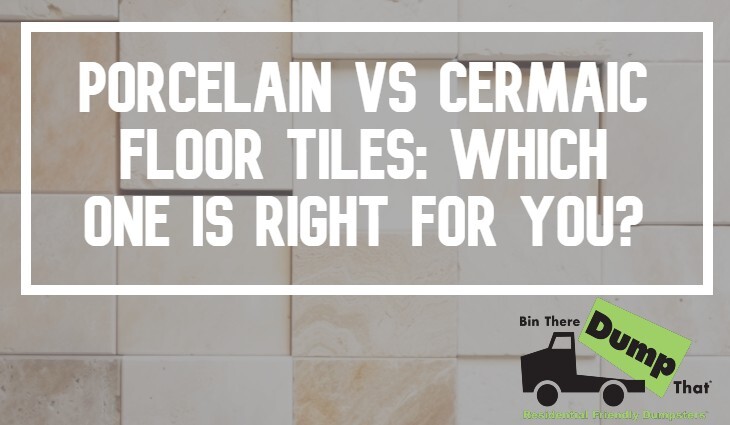
Porcelain vs Ceramic Floor Tiles: Which one is right for you?
When it comes to choosing the perfect floor tile for your home, the debate between porcelain and ceramic tiles is a common dilemma. Both options offer an array of benefits, and understanding the differences between them is crucial in making an informed decision. In this article, we'll explore the key distinctions between porcelain and ceramic floor tiles and help you determine which one is the right fit for your specific needs.
Porcelain and Ceramic: The Basics
Porcelain and ceramic floor tiles are both versatile and widely used in interior design. While they may seem quite similar at first glance, their composition, durability, and ideal applications differ significantly.
Ceramic floor tiles are made from a mixture of clay, minerals, and water. This mixture is shaped, dried, and then fired in a kiln at lower temperatures. On the other hand, porcelain tiles are crafted from a more refined clay, often mixed with finely ground sand. This mixture is then fired at extremely high temperatures, resulting in a denser and less porous tile.

Porcelain vs Ceramic: The Differences Between Porcelain and Ceramic
Durability:
One of the most notable differences between porcelain and ceramic is their durability. Porcelain floor tiles are highly dense and less porous due to their manufacturing process, making them more resistant to moisture, stains, and wear. This characteristic makes porcelain tiles an excellent choice for high-traffic areas and even outdoor applications. On the other hand, ceramic floor tiles, while durable, are more porous and might not be as well-suited for heavy-duty use.
Water Resistance:
Porcelain's low porosity makes it highly water-resistant, making it an ideal choice for environments with high humidity, such as bathrooms and kitchens. Porcelain shower tiles are particularly popular due to their ability to withstand prolonged exposure to moisture without compromising their integrity. While ceramic tiles are still suitable for areas with occasional moisture, they might require more maintenance to prevent water absorption over time.
Versatility:
Both porcelain and ceramic tiles come in a wide range of colors, sizes, and patterns, giving you plenty of options to match your design preferences. However, porcelain tiles often have more intricate patterns and designs, thanks to their finer clay composition. This makes porcelain a favored choice for creating intricate bathroom designs or decorative accents.
Application:
Due to its exceptional durability and water resistance, porcelain is commonly used for high-traffic commercial spaces, outdoor patios, and areas prone to moisture exposure. On the other hand, ceramic tiles find their niche in residential settings, especially in living rooms, bedrooms, and areas with less foot traffic.
Price Point:
Generally, ceramic tiles are more budget-friendly than porcelain tiles. While porcelain's durability and performance make it a worthwhile investment, ceramic tiles can provide an attractive option for those on a tighter budget.
Installation:
Both porcelain and ceramic tiles require similar installation methods, involving adhesive and grout. However, due to their density, porcelain tiles can be slightly more challenging to cut and shape during installation.

Porcelain Shower Tiles and Ceramic Tile Bathrooms
When it comes to designing bathrooms, both porcelain and ceramic tiles have their merits. Porcelain shower tiles are an excellent choice for creating a spa-like retreat. Their water resistance and durability make them perfect for shower walls and floors, where exposure to moisture is constant. Additionally, their intricate designs can transform your bathroom into an elegant oasis.
Ceramic tiles, while still a suitable option, might require more care in a bathroom setting. Using them on bathroom walls or floors can be a stylish choice, especially if you're drawn to their unique patterns and textures. However, given their slightly higher porosity, it's important to ensure proper sealing and maintenance to prevent water damage over time.
Making the Right Choice for You
In the porcelain vs ceramic debate, the choice ultimately boils down to your specific needs and preferences. Here are some considerations to help you make an informed decision:
Location and Use: It's crucial to assess the intended installation area and the anticipated level of foot traffic or moisture exposure the space will have when comparing porcelain vs ceramic tiles.
Budget: Consider your budget constraints and weigh the benefits of durability and water resistance against the cost difference between the two options.
Aesthetic Preferences: Think about the design style you want to achieve. Porcelain tiles offer intricate designs, while ceramic tiles provide a wide range of patterns and textures.
Maintenance: Evaluate how much time and effort you're willing to invest in maintenance. Porcelain's low porosity requires less upkeep in the long run.
Porcelain vs Ceramic: Making a Decision
Choosing between porcelain and ceramic floor tiles requires careful consideration of their differences in composition, durability, water resistance, versatility, and application. Porcelain's density and low porosity make it a superior choice for high-traffic areas and spaces exposed to moisture, while ceramic tiles offer budget-friendly options with a wide range of design possibilities.
Whether you're envisioning a luxurious porcelain shower tile or a charming ceramic tile bathroom, understanding the strengths of each type will guide you toward the perfect choice for your home.
If you'd like to learn how to remove ceramic floor tiles, check out our article on that here!

No comments:
Post a Comment